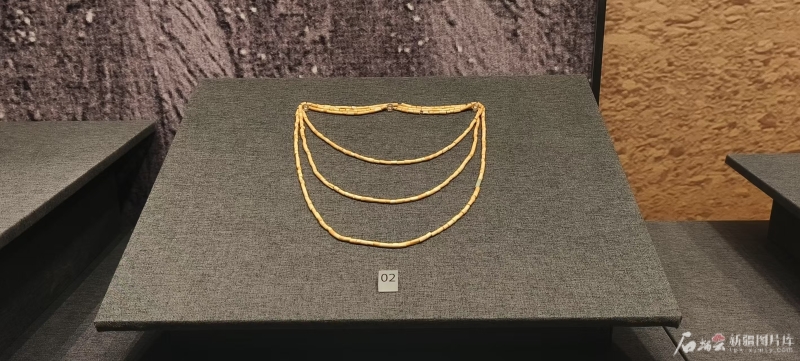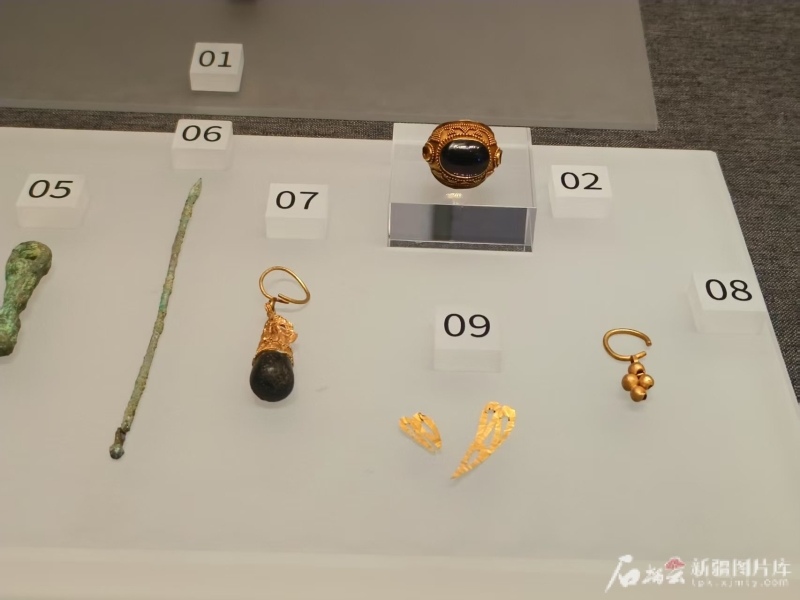Shiliuyun-Xinjiang Daily (Reporter Wang Xinhong) news: "The love of beauty dwells in every heart; the art of adornment flows through centuries." Within the display cases of the Xinjiang Museum in northwest China’s Xinjiang, and ancient cosmetic artifacts used by women over millennia lie in quiet repose. These artifacts, imbued with the spirit of Silk Road civilization, silently unravel the aesthetic codes of the Western Regions.

Photo shows a bone-made ornament displayed in the Xinjiang Museum, Urumqi, capital city of northwest China’s Xinjiang Uygur Autonomous Region. (Photo by Shiliuyun-Xinjiang Daily/Wang Xinhong)
Necklaces, earrings, bracelets, rings, hair accessories... The Xinjiang Museum’s galleries unveil a dazzling array of adornments once cherished by ancient women of the region. Among the highlights is a Han Dynasty (206 BCE-220 CE) glass bead necklace unearthed from the Shanpula Cemetery in Lop County, Xinjiang’s Hotan Prefecture. Its alternating amber-hued glass beads and turquoise stones retain their smooth, well-preserved surfaces despite two millennia of exposure.

Photo shows a carbon ornament displayed in the Xinjiang Museum, Urumqi, capital city of northwest China’s Xinjiang Uygur Autonomous Region. (Photo by Shiliuyun-Xinjiang Daily/Wang Xinhong)
The museum’s collection of ear ornaments captivates with their timeless charm. Among the displayed pieces—gold earrings with stone pendants, triple-goat motif gold earrings, gem-encrusted gold drops, grape-pendant gold earrings, and bronze earrings—each exudes distinct allure. A standout is a 2,500-year-old pendant earring crafted from gold and jade. Its gold component, etched with minimalist patterns, suspends a crescent-shaped jade that evokes a bird mid-flight, swaying gently with the wearer’s movements.

Photo shows gold rings set with gemstones and gem-encrusted gold earrings displayed in the Xinjiang Museum, Urumqi, capital city of northwest China’s Xinjiang Uygur Autonomous Region. (Photo by Shiliuyun-Xinjiang Daily/Wang Xinhong)
According to the docent of the museum, earrings were essential for women in ancient Xinjiang. Among the exhibited artifacts, earrings showcase remarkable diversity—ranging from minimalist metal hoops to ornate gemstone pendants. "These pieces not only accentuated facial beauty but also embodied the aesthetic ideals of ancient women," the docent noted.

Photo shows gold ornaments displayed in the Xinjiang Museum, Urumqi, capital city of northwest China’s Xinjiang Uygur Autonomous Region. (Photo by Wang Xinhong)
In the Xinjiang Museum’s collection, the splendor of wrist ornaments shines brightly. Coral bracelets, coral beaded strands, gold bead chains, bangles, and copper bead accessories once graced the arms of ancient women. A Han Dynasty (206 BCE-220 CE) coral bracelet and beads from the Shanpula tombs in Luopu County retain vibrant hues that rival modern trendy accessories. A gold bead chain from the Dongtalade Cemetery in Habahe County mirrors the design of today’s luxury jewelry, its craftsmanship indistinguishable from contemporary high-end pieces. Bronze bangles unearthed from the Xiabandi tombs in Taxkorgan Tajik Autonomous County, dating back 2,500–3,600 years, bear a delicate green patina yet radiate enduring charm. The collection also features a Han Dynasty gem-inlaid gold ring from the Xiate tombs in Zhaosu County, along with hairpins, “buyao” (pendant hairpins), and “huadian” (decorative forehead ornaments), showcasing the timeless artistry of ancient adornments.The collection peaks with a Han Dynasty gold ring inset with gemstones from Xiate Cemetery in Zhaosu County, alongside hairpins, “buyao” (pendant hairpins), “huadian” (forehead ornaments), and other coiffure-enhancing treasures.

Photo shows coral ornaments and coral bracelets displayed in the Xinjiang Museum, Urumqi, capital city of northwest China’s Xinjiang Uygur Autonomous Region. (Photo by Wang Xinhong)
These artifacts, bridging millennia through universal pursuits of the wisdom, emotions, and aesthetic tastes of the ancients, offer tangible connections to Xinjiang’s multicultural past. Xinjiang Museum has continuously invited visitors to decode the aesthetics of ancient Silk Road civilizations.
(A written permission shall be obtained for reprinting, excerpting, copying and mirroring of the contents published on this website. Unauthorized aforementioned act shall be deemed an infringement, of which the actor shall be held accountable under the law.)









